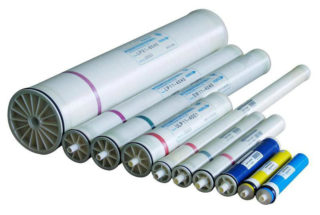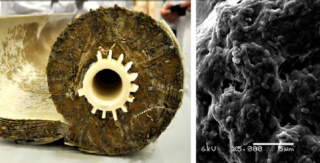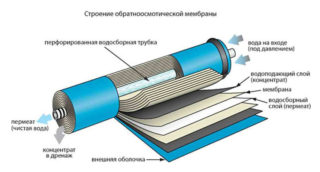Reverse osmosis filters are a reliable way to purify water. They are used in everyday life and at enterprises for the desalination of salt water. The essence of the process is to pass the liquid through a microporous membrane so that all salts remain on one side, and water molecules on the other. In this case, an integrated approach is preferable to prepare the dirty liquid for filtration through the membrane. This will increase the service life.
Purpose of the reverse osmosis membrane

Reverse osmosis systems are popular and are the main competitors for distillation plants. The reverse osmosis method makes it possible to obtain cheaper drinking water. The developers went further and created mineralizers that recover the salts filtered out in the process. As a result, real mineral water is obtained at the outlet.
Bacteria and viruses cannot pass through the microfilter, but this largely depends on the size of the cells. Here it is necessary to distinguish nanofiltration, ultrafiltration and the principle of reverse osmosis: with nanofiltration the pore size is 0.001 microns, with reverse osmosis 0 0.1 microns. During ultrafiltration, dissolved salts pass through the membrane, but microorganisms are retained.
Heavy metals also cannot pass through the cells due to the huge size of the molecules. Lead, for example, is not felt in any way in drinking water, but accumulating in the tissues of the brain, over time, it can cause neurological diseases, and in children, mental retardation.
Reverse osmosis membranes are used in the medical and food industries, as well as in the production of alcoholic beverages. Powerful installations filter liquids in water bottling plants.
Device and principle of operation
Polymers are used as material. One of them, aragon, increases the amount of easily assimilable calcium - aragonite - in the filtrate. The basis for any filter is cellulose acetate, which is combined with polypropylene. This is the cheapest option. There are more expensive ones that can withstand exposure to chemicals and heat. The most resistant are ceramic membranes; products made of PVDF and PAN are inferior to them.
For the normal functioning of the membrane, several rules must be observed:
- system pressure from 3 to 5 atmospheres;
- fluid temperature;
- timely replacement of the filter based on the manufacturer's recommendations.
People living in high-rise buildings need to additionally install a pump to increase the pressure, otherwise the filtration will not be effective. Due to the very small size of the cells, the liquid cannot pass through them on its own. Dirty water must be squeezed under pressure. On high floors, it can be weak.
In household installations that filter cold liquid, an increase in temperature above 40 degrees can damage the pores due to shrinkage of the material and failure of the membrane.
It is simple to rinse the reverse osmosis membrane body: you need to reduce the pressure and wait until the accumulated dirt is washed off with a stream. Sometimes a weak solution of hydrochloric acid or special flushing fluids are used.
For each type of filter, its own pressure is determined, so when installing, you need to read the instructions or entrust the work to professionals. With proper operation, the membrane, depending on the brand of the manufacturer, lasts from 2 to 4 years.
Many potential buyers are interested in the question of what percentage of clean liquid can be obtained from the total amount of used water. Previously, this figure was about 30%, the rest of the liquid went down the drain as unusable. Now we can talk about 85% of the total consumption, but this indicator needs to be clarified when choosing - it is different for each manufacturer.
Criterias of choice

First of all, you need to take water for analysis in order to know the composition of the liquid to be cleaned. Since the membrane filter has different pore sizes, it is important to know which substances need to be protected from - mineral or organic, heavy metals or bacteria.
There is such a design element as a drain flow restrictor - this is the second important point that reduces fluid consumption. It is selected depending on the performance of the membrane: for 36 gallons - 300 ml / minute, 50 gallons - 350 ml, 75 gallons - 420 ml, 100 gallons - 550 ml.
One of the selection criteria is the price. Reverse osmosis plants are not cheap, so at the initial stage people try to save money. This is the wrong approach, as cheap installations are usually expensive to maintain. Before buying, you need to know how often you need to change cartridges and how much they cost. In expensive models, replacement is less frequent, but the installation itself requires more serious costs.
Installation features
When installing the filtering equipment, the master does all the work, but later the cartridges will have to be changed on their own. This is a straightforward process, and most of the membrane filters are compatible with the rest of the models. For example, you can put the Atoll membrane on the Geyser installation and vice versa.
It is necessary to change the membrane filter when the device begins to slowly accumulate water. If at first the tank was filled in an hour, then after a year and a half it takes 4–5 hours.
The membrane is located between the mechanical filter and the carbon filter. The instructions describe this in detail. Also, at the first visit, the master can show the replacement process, and the owner can try to pull out the case and put it back.
Operation and maintenance

The main thing in operation is to correctly adjust the pressure in the system so that the filter does not clog and soften. Expensive reverse osmosis membranes last longer, they can be descaled, which many people do in order not to buy a part again.
You can clean the membrane from biofilm on your own using conventional detergents, but this must be done regularly so that organic matter does not penetrate into all layers of the filter. If the mucus clogs the pores, and the membrane does not function, you need to bring it to a specialized company, where all layers will be cleaned with the help of chemicals. Chlorine dioxide is recognized as the best reagent. It has a prolonged action and after its application, the membrane does not need to be flushed for a long time. The substance is completely safe for drinking water.
Prices for a membrane for a reverse osmosis filter differ dramatically, since the products have different performance. More economical ones are more expensive, membranes made of durable materials are also not cheap and will last longer than conventional ones.









